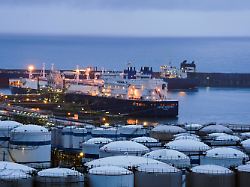For the first time, the EU is planning sanctions against Russian LNG exports. Imports into EU countries will remain unaffected. Restrictions only apply at European ports – when handling Russian liquefied gas for the world market.
Moscow’s gas trade with the European Union is flourishing. So far, there are no sanctions against the import of pipeline or liquefied natural gas (LNG) from Russia. This is not only practical for the Kremlin because it allows it to supply EU member states without disruption. It also benefits from the favorable location of European ports, which serve as transshipment points for its LNG for the Asia-Pacific region. The European heads of state and government want to prevent this re-export on Europe’s coasts with their planned 14th sanctions package.
Russia is the second largest supplier of LNG to the European Union after the USA. In May of this year alone, according to the Brussels think tank Bruegel, Moscow shipped more than 1.9 million cubic meters of Russian liquefied gas to the EU, while the United States shipped around 4.3 million cubic meters.
Since the beginning of the invasion of Ukraine in 2021, the EU has imported significantly less gas via pipelines than before. However, imports of Russian LNG have increased. This is the conclusion of a study by the climate protection organization Research on Energy and Clean Air (CREA). According to the study, the EU imported at least 20 billion cubic meters of Russian LNG in 2023. Almost a quarter of this was transshipped in European ports in Belgium, Spain and France and shipped on to countries such as China. The new sanctions package is aimed at these transshipment points.
For Michael Rochlitz, Professor of Russian Economics at St. Antony’s College, Oxford University, the sanctions are just a drop in the ocean. The ban on the handling of Russian LNG in European ports is not a “game changer” in itself, Rochlitz told ntv.de. “The Russian economy is currently booming primarily because the Kremlin is investing heavily in the war economy,” Rochlitz said. This will be financed by reserves created before 2022, the export of gas and oil to India and China, and in the near future also by higher taxation of Russian companies. The Kremlin’s highest priority continues to be the advancement of the invasion of Ukraine. This leads to a vicious circle. “As a result of the massive expansion of the arms industry, a lobby group is emerging that is committed to continuing the war,” Rochlitz said.
In 2023, the EU paid eight billion euros for Russian LNG
Nevertheless, LNG exports to the European Union remain a source of income for Moscow. According to CREA, the EU is the largest customer for Russian LNG – it paid more than eight billion euros for it last year. European companies also earn money from re-exports. The gas also reaches Germany through transshipment at ports, albeit in small quantities. Experts and environmentalists estimate that the share of Russian liquefied gas in Germany’s gas supply is in the mid-single-digit to low double-digit percentage range.
Szymon Kardaś, energy expert in the Warsaw office of the European Council on Foreign Relations, also doubts that the planned EU sanctions will tear large holes in Putin’s war chest. The share of LNG in total Russian energy exports is too small for that, Kardaś tells ntv.de. Liquefied gas only accounts for around 15 percent of Russian energy exports. Trade in crude oil and oil products is more important.
“Russia actually had great ambitions for the production and export of liquefied gas. It wanted to reach a production capacity of 140 million tons by 2025,” says Kardaś. But the dream has been shattered. The reason for this is the impact of sanctions that were decided by the EU and the USA years ago. They have nothing to do with the package that the European heads of state and government now want to adopt.
High-tech sanctions hit LNG plants in Siberia
Rather, it is the indirect impact of the embargoes on high-performance technologies that were imposed shortly after the start of the Russian war of aggression. This is causing problems for Russia, especially with LNG transport. Moscow lacks the technical know-how to further develop its fleet. It can no longer manufacture icebreakers, for example. But they are necessary for the journey through Arctic waters in front of the LNG terminals in Siberia.
The Arctic LNG 2 project of the Russian company Novatek in northern Siberia on the Gydan Peninsula is particularly suffering from the sanctions. The plant’s first production line was completed in 2023. This production line was actually supposed to export 6.6 million tons of LNG per year. “But nothing has yet been shipped from Arctic LNG 2. The high-performance technology for this is missing. As a result, Russia has so far been unable to comply with some of the gas supply contracts it has signed with France, for example,” said Kardaś.
